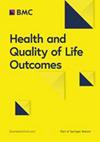以性别为导向分析住院肝硬化患者骨骼肌的数量和质量及其与生活质量的关系
IF 3.2
2区 医学
Q1 HEALTH CARE SCIENCES & SERVICES
引用次数: 0
摘要
考虑到男性与女性肌肉疏松症/肌营养不良症的病理生理差异,以性别为导向分析肌肉数量和质量与健康相关生活质量(HRQoL)之间联系的数据非常少。我们试图研究失代偿期肝硬化患者的骨骼肌指数(SMI)定义的肌肉疏松症和肌肉内脂肪组织含量(IMAC)定义的肌营养不良症与EQ-5D(EuroQol-5D)定义的HRQoL之间的关系,其中涉及性别差异。共有 382 名患者入选。通过限制性三次样条分析和皮尔逊相关分析评估了 SMI/IMAC 与 HRQoL 之间的关系。此外,SMI 或肌肉疏松症与 EQ-5D 实用指数之间的关系是通过多元线性回归确定的,并对年龄、体重指数和并发疾病严重程度进行了调整。研究人群中男女比例均衡(190:192),平均年龄为 61.9 岁。男性的肌肉疏松症(40.5% 对 9.9%,P < 0.001)和 SMI(48.8 cm2/m2 对 42.2 cm2/m2,P < 0.001)发病率明显高于女性,而肌骨质疏松症的发病率则相当(15.3% 对 16.7%,P = 0.708)。与非肌少症组别相比,在整个人群中,肌少症组别在自我护理、日常活动和 EQ-5D 量表中的疼痛发生率均高于非肌少症组别,并按性别进行了分层。在男性患者中,SMI 值与 EQ-5D 实用性指数呈明显的线性相关,而在女性患者中则不然(非线性 P = 0.281)。在多重分析中,SMI 或肌肉疏松症的存在均与 EQ-5D 实用指数有显著相关性。分组分析显示,肌肉疏松症与 EQ-5D 实用指数之间没有明显的交互作用。以 SMI 测量的肌肉量与 HRQoL 下降相关的是男性而非女性,而以 IMAC 测量的肌肉质量与男女两性均无关联。通过尽可能提高 SMI 水平来控制肌肉疏松症,希望达到更好的健康效果,这很有诱惑力。我们的研究结果表明,将 CT 标记的身体成分异常与以患者为中心的有意义的结果联系起来非常重要。未来有必要对相当规模的多中心人群进行有针对性的研究,以澄清这一因果关系,从而针对肌肉疏松症/骨质疏松症或影响 HRQoL 的关键因素制定优化干预措施。本文章由计算机程序翻译,如有差异,请以英文原文为准。
A sex-oriented analysis concerning skeletal muscle quantity and quality and associations to quality of life in hospitalized patients with cirrhosis
There is a paucity of data regarding sex-oriented analyses of connection between muscle quantity and quality and health-related quality of life (HRQoL), taking into account the pathophysiological differences of sarcopenia/myosteatosis in males versus females. We sought to investigate the associations between skeletal muscle index (SMI)-defined sarcopenia and intramuscular adipose tissue content (IMAC)-defined myosteatosis and EuroQol-5D (EQ-5D)-defined HRQoL in patients with decompensated cirrhosis concerning sex disparities. Totally, 382 patients were enrolled. The relationship between SMI/IMAC and HRQoL was evaluated with restricted cubic spline and Pearson correlation analyses. Furthermore, association between SMI or sarcopenia and EQ-5D utility index was determined by multiple linear regression, adjusted for age, BMI and concurrent disease severity. The study population comprised evenly distributed male and female patients (190: 192), mean age 61.9 years. The prevalence of sarcopenia (40.5 versus 9.9%, P < 0.001) and SMI (48.8 versus 42.2 cm2/m2, P < 0.001) were significantly higher in males relative to females, with comparable myosteatosis prevalence (15.3 versus 16.7%, P = 0.708). Self-care, usual activities and pain within EQ-5D scale were more prevalent in the sarcopenia compared with non-sarcopenia groups across entire population and stratified by sex. The SMI values exhibited a significantly linear correlation with EQ-5D utility index in male but not female patients (P for non-linearity = 0.281). In multiple analysis, SMI or the presence of sarcopenia was both significantly associated with EQ-5D utility index. Subgroup analyses unveiled no discernible interactions between sarcopenia and EQ-5D utility index. Muscle quantity measured by SMI was associated with declined HRQoL in males rather than females, whereas no associations were found regarding muscle quality measured by IMAC in both sexes. It is tempting to manage sarcopenia by increasing SMI levels as high as possible in hopes of achieving better health consequence. Our findings represent the importance of connecting CT-demarcated body composition abnormalities to meaningful patient-centered outcomes. Future targeted studies with sizable multi-center populations are warranted to clarify this causality, and in consequence develop optimized intervention against sarcopenia/myosteatosis or key determinants concerning impaired HRQoL.
求助全文
通过发布文献求助,成功后即可免费获取论文全文。
去求助
来源期刊
CiteScore
7.30
自引率
2.80%
发文量
154
审稿时长
3-8 weeks
期刊介绍:
Health and Quality of Life Outcomes is an open access, peer-reviewed, journal offering high quality articles, rapid publication and wide diffusion in the public domain.
Health and Quality of Life Outcomes considers original manuscripts on the Health-Related Quality of Life (HRQOL) assessment for evaluation of medical and psychosocial interventions. It also considers approaches and studies on psychometric properties of HRQOL and patient reported outcome measures, including cultural validation of instruments if they provide information about the impact of interventions. The journal publishes study protocols and reviews summarising the present state of knowledge concerning a particular aspect of HRQOL and patient reported outcome measures. Reviews should generally follow systematic review methodology. Comments on articles and letters to the editor are welcome.

 求助内容:
求助内容: 应助结果提醒方式:
应助结果提醒方式:


